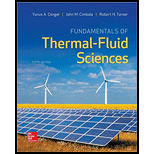
(a)
The rate of heat removal from the breads.
(a)
Explanation of Solution
Given:
The number of loaves per hours is
The average mass per bread is
The mass flow rate of breads loves
The specific heat of bread loves
The latent heat of bread loves
The initial temperature of the bread
The final temperature of the bread
The COP of the refrigerator
Calculation:
Calculate the mass flow rate of the bread.
Calculate the average temperature of bread.
Refer the Table A-1, “Molar mass, gas constant, and critical-point properties” to obtain value of gas constant of air as
Calculate the rate of removal of heat from the breads.
Calculate the rate of cooling of bread.
Calculate the total rate of heat removal from bread.
Thus, the rate of heat removal from the breads is
(b)
The required volume flow rate of air.
(b)
Explanation of Solution
Refer the Table A-2, “Ideal-gas specific heats of various common gases” to obtain value of specific heat of pressure of air at approx.
Calculate the mass flow rate of air.
Calculate the density of the air.
Calculate the volume flow rate of air.
Thus, the required volume flow rate of air is
(c)
The size of the compressor of the refrigeration system.
(c)
Explanation of Solution
Calculate the size of the compressor of the refrigeration system.
Thus, the size of the compressor of the refrigeration system is
Want to see more full solutions like this?
Chapter 7 Solutions
Fundamentals of Thermal-Fluid Sciences
 Elements Of ElectromagneticsMechanical EngineeringISBN:9780190698614Author:Sadiku, Matthew N. O.Publisher:Oxford University Press
Elements Of ElectromagneticsMechanical EngineeringISBN:9780190698614Author:Sadiku, Matthew N. O.Publisher:Oxford University Press Mechanics of Materials (10th Edition)Mechanical EngineeringISBN:9780134319650Author:Russell C. HibbelerPublisher:PEARSON
Mechanics of Materials (10th Edition)Mechanical EngineeringISBN:9780134319650Author:Russell C. HibbelerPublisher:PEARSON Thermodynamics: An Engineering ApproachMechanical EngineeringISBN:9781259822674Author:Yunus A. Cengel Dr., Michael A. BolesPublisher:McGraw-Hill Education
Thermodynamics: An Engineering ApproachMechanical EngineeringISBN:9781259822674Author:Yunus A. Cengel Dr., Michael A. BolesPublisher:McGraw-Hill Education Control Systems EngineeringMechanical EngineeringISBN:9781118170519Author:Norman S. NisePublisher:WILEY
Control Systems EngineeringMechanical EngineeringISBN:9781118170519Author:Norman S. NisePublisher:WILEY Mechanics of Materials (MindTap Course List)Mechanical EngineeringISBN:9781337093347Author:Barry J. Goodno, James M. GerePublisher:Cengage Learning
Mechanics of Materials (MindTap Course List)Mechanical EngineeringISBN:9781337093347Author:Barry J. Goodno, James M. GerePublisher:Cengage Learning Engineering Mechanics: StaticsMechanical EngineeringISBN:9781118807330Author:James L. Meriam, L. G. Kraige, J. N. BoltonPublisher:WILEY
Engineering Mechanics: StaticsMechanical EngineeringISBN:9781118807330Author:James L. Meriam, L. G. Kraige, J. N. BoltonPublisher:WILEY





